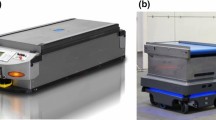Abstract
The high degree of variety in customer demands causes mass production to become outdated and flexible production to be favored. Routing flexibility can be found in systems that implement general-purpose machines, alternative or identical machines, redundant machine tools, or the versatility of material handling systems. It is recognized that routing flexibility can be treated as a tool for enhancing system performance, such as lead time and inventory reduction. However, its implementation entails a huge cost of installation of flexible machines, automated tool changers and fixtures, and machine operators possessing multiple skills. Therefore, system managers must determine the appropriate level of routing flexibility for a specific system configuration in order to balance benefits and costs incurred. This paper presents a background to and a rational for a routing flexibility measure for a multi-stage flow shop. Instead of merely counting the number of available routes, this measure takes into account the loading balance between machines. Therefore, a manufacturing system with overloaded machines will have less routing flexibility as compared with one that is not overloaded, when both systems have the same number of available routes. An example for demonstrating the applicability of the proposed measure is also illustrated.
Similar content being viewed by others
References
Sethi AK, Sethi SP (1990) Flexibility in manufacturing: a survey. Int J Flex Manuf Syst 2:289–328 doi:10.1007/BF00186471
Clark K, Hayes R, Wheelwright S (1988) Dynamic manufacturing: creating the learning organization. Free Press, New York
Browne J, Dubois D, Rathmill K, Sethi SP, Stecke KE (1984) Classification of flexible manufacturing systems. FMS Mag 2(2):114–117
Yao D, Pei F (1990) Flexible parts routing in manufacturing systems. IIE Trans 22:48–55 doi:10.1080/07408179008964157
Benjaafar S, Ramakrishnan R (1993) The effect of routing and machine flexibility on performance of manufacturing systems. Second Industrial Engineering Research Conference Proceedings, pp 445–450
Carter MF (1986) Designing flexibility into automated manufacturing systems. Proceedings of the second ORSA/TIMS conference on flexible manufacturing systems: operations research models and application, pp 107–118
Bobrowski PM, Mabert VA (1988) Alternate routing strategies in batch manufacturing: an evaluation. Decis Sci 19(4):713–733 doi:10.1111/j.1540-5915.1988.tb00297.x
French S (1982) Sequencing and scheduling: an introduction to the mathematics of the job-shop. Wiley, New York
Garavelli AC (2001) Performance analysis of a batch production system with limited flexibility. Int J Prod Econ 69:39–48 doi:10.1016/S0925-5273(00)00043-8
ElMekkawy TY, ElMaraghy HA (2003) Real-time scheduling with deadlock avoidance in flexible manufacturing systems. Int J Adv Manuf Technol 22:259–270 doi:10.1007/s00170-002-1468-y
Nasr N, Elsayed EA (1990) Job shop scheduling with alternative machines. Int J Prod Res 28(9):1595–1609 doi:10.1080/00207549008942818
Stecke KE, Kim I (1988) A study of FMS part type selection approaches for the short-term production planning. Int J Flex Manuf Syst 1(1):7–29 doi:10.1007/BF00713157
Chatterjee A, Cohen MA, Maxwell WC (1984) Manufacturing flexibility: models and measurement. Proceedings of the First ORSA/UMS special interest conference, pp 49–64
Chung CH, Chen IJ (1989) A systematic assessment of the value of flexibility for an FMS. Proceedings of the third ORSA/TIMS conference on flexible manufacturing systems: operations research models and applications, pp 27–32
Bernardo J, Mohamed Z (1992) The measurement and use of operational flexibility in the loading of flexible manufacturing systems. Eur J Oper Res 60:144–155 doi:10.1016/0377-2217(92)90089-R
Das SK, Nagendra P (1993) Investigations into the impact of flexibility on manufacturing performance. Int J Prod Res 31(10):2337–2354 doi:10.1080/00207549308956861
Kumar V (1987) Entropic measures of manufacturing flexibility. Int J Prod Res 25(7):957–966 doi:10.1080/00207548708919888
Piplani R, Wetjens D (2007) Evaluation of entropy-based dispatching in flexible manufacturing systems. Eur J Oper Res 176:317–331 doi:10.1016/j.ejor.2005.06.066
Chang A-Y (2007) On the measurement of routing flexibility: a multiple attribute approach. Int J Prod Econ 109:122–136 doi:10.1016/j.ijpe.2006.11.011
Author information
Authors and Affiliations
Corresponding author
Rights and permissions
About this article
Cite this article
Yu, MC., Greene, T.J. An operational measure of routing flexibility in a multi-stage multi-product production system. Int J Adv Manuf Technol 43, 357–364 (2009). https://doi.org/10.1007/s00170-008-1711-2
Received:
Accepted:
Published:
Issue Date:
DOI: https://doi.org/10.1007/s00170-008-1711-2




